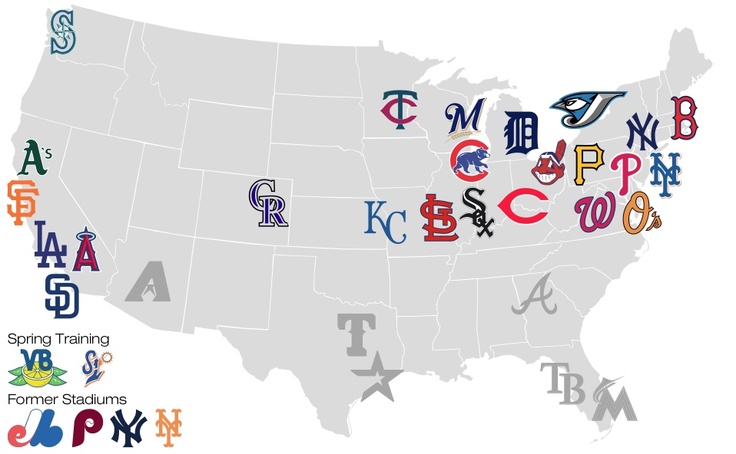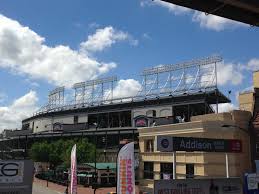
Photo Source: Pinterest.com
Traveling and seeing all 30 Major League Ballparks is the summertime goal of many baseball fanatics. Attaining this feat is a little different than visiting venues of any other sport. Each ballpark is so different and unique, varying in size, age and character. You have the nostalgic ballparks like Fenway Park, Wrigley Field and Dodger Stadium. You have the new era ballparks like Camden Yards, Progressive Field and the Rogers Centre. And then you have the shiny new ballparks like Marlins Park, Citi Field and Yankee Stadium. Did I mention it all takes place during the best weather of the year? From This Seat is going to show you how to cut down on costs on your quest to see as many ballparks as possible next summer.
1. Keep in mind the date of the game and the time of year.
If you’re planning a trip to Detroit, Minnesota, Cleveland, Boston, New York, etc. in April, it’s going to be very cold outside. I love baseball but I hate sitting out in the cold. By waiting until August or September to make your ballpark visits, you’re going to be ensured to have warmer weather and less rain. You’ll also be guaranteed cheaper ticket prices since a lot of teams will be out of playoff contention at that time of the year. Keep in mind that day games and weeknight games will also be a cheaper ticket compared to a weekend game on Friday or Saturday.
Your best outlet for MLB tickets in my opinion is Ticket Monster; no checkout or shipping fees and they’ve become one of Stubhub’s largest competitors. The closer you wait until game time, the cheaper your tickets could be due to the drop in price for unsold inventory. Purchasing tickets two days before a baseball game could save you 30% vs. purchasing a month prior to the event. If you want cheap tickets that are in close proximity to the field and don’t mind sacrificing a little bit of comfort, most MLB ballparks have bleacher seating. Bleacher seats consistently offer the most bang for your buck league wide.
-
Pay attention to which ballparks are in close proximity to each other.
Print the full season schedules of the home teams you want to see. ESPN has excellent printable schedules which can be found here at ESPN.com. To the far right of the page, select a team’s schedule and once you arrive on the team schedule page, select “printable schedule”.
3. After your schedules are printed out, plan your trip in legs.
For trip #1 listed below, for example, you’ll want to plan these visits during the same week since they’re all so close in proximity. This can be done by easily utilizing Amtrak, Megabus, SEPTA, Port Authority Bus Terminal, New Jersey Transit, etc.
Multiple Ballpark Visits on the same trip.
- Trip 1: Citizens Bank Park (Philadelphia Phillies), Citi Field (New York Mets), Yankee Stadium (New York Yankees), Fenway Park (Boston Red Sox).
- Trip 2: Dodger Stadium (Los Angeles Dodgers), Angel Stadium of Anaheim (Anaheim Angels), Petco Park (San Diego Padres).
- Trip 3: O.co Coliseum (Oakland Athletics), AT&T Park (San Francisco Giants).
- Trip 4: Globe Life Park in Arlington (Texas Rangers), Minute Maid Park (Houston Astros).
- Trip 5: Busch Stadium (St. Louis Cardinals), Kauffman Stadium (Kansas City Royals), Great American Ballpark (Cincinnati Reds).
- Trip 6: Wrigley Field (Chicago Cubs), U.S. Cellular Field (Chicago White Sox), Miller Park (Milwaukee Brewers).
- Trip 7: PNC Park (Pittsburgh Pirates), Progressive Field (Cleveland Indians), Comerica Park (Detroit Tigers).
- Trip 8: Camden Yards (Baltimore Orioles), Nationals Park (Washington Nationals).
- Trip 9: Tropicana Field (Tampa Bay Rays), Marlins Park (Miami Marlins).
Ballparks that will require their own individual trip.
- Safeco Field (Seattle Mariners).
- Coors Field (Colorado Rockies).
- Turner Field (Atlanta Braves).
- Chase Field (Arizona Diamondbacks).
- Target Field (Minnesota Twins).
- Rogers Centre (Toronto Blue Jays).
-
Make hotel arrangements ahead of time.
Don’t get caught up searching too hard on the countless number of travel sites for the cheapest hotel. They all use the same resources to determine market price for a hotel room. Instead, call the hotel directly and see if they can offer you a cheaper rate than the travel websites. Most times, they can. Are you a AAA member? You’ll most likely be able to get a discount for that. If you want a nice hotel for an affordable price, it doesn’t get much better than Hampton Inn in my opinion. Consider how much time you’ll actually spend in the hotel when booking a room. Why spend $300 a night at the Four Seasons if you’ll only be there to sleep? The bigger the event, the further you should book ahead of time (Super Bowl, World Series, etc.)
Look for hotels that offer a free breakfast buffet, again, Hampton Inn has great breakfasts. Free WI-FI and free parking should also be factors you consider when booking your hotels. If you still prefer to use one of the travel sites, keeping it simple with Hotels.com is the best way to go in my opinion.
-
Get familiar with public transportation.
Most ballparks will be serviced by subway or metro systems with unlimited rides for $5 a day sometimes (varies by city). I wouldn’t recommend driving in a lot of these cities and self-parking. Too much of a headache, too many one way streets and too much of a chance of getting lost in an unknown place. Plus, self-parking for games for less than $20 is difficult to find in most cities. If you do choose to self-park, consider purchasing parking ahead of time with Park Whiz. Taking taxis from the hotel to the ballpark isn't a bad option but you still have to deal with the traffic that can easily be avoided with subway systems.

Photo Source: TheCollegeTourist
-
Getting to the City the ballpark is in.
Getting to most of the Major League cities can be done in most cases via Megabus or Amtrak. Both will often drop you off at each cities central hub (Grand Central Station, Penn Station, etc). I’ve found round trip bus rides from Cincinnati to Atlanta for as little as $30 on Megabus. Check out each website to see if they service an area near where you reside. Consider flying with Allegiant Air for any trip to Florida you make. They have round trip flights for $140 depending on how soon you book. The only downside? They charge more for bags and you can only leave and return on certain days.
7. Bring your own food into the ballpark.
Most ball clubs will allow you to bring bottled water and food into the ballpark these days as long as it's properly sealed in a see-thru bag. If you’re feeling frisky and are over 21 years old, try sneaking a few beers into the ballpark. Asking fans to pay $10 for a beer is just highway robbery.
The second option when it comes to keeping food expenses down is eating before the game begins. Would you rather pay $16 for a beer and hot dog or $7 for a full meal at Chipotle? Again, this is only if you’re on a budget.
We hope you found these tips to be useful. Be sure to share your travels and leave reviews for your seats on all of our MLB Ballpark pages when you return!
JUMP TO
- 5 Cool Features at Major League Ballparks you Probably Didn't Know About
- ESPN's Sunday Night Baseball Crew Wraps up "Sunday From The Seats"
- Buying Tickets from Scalpers Post Start Time. Risk or Reward?
- What It's Like Walking Into your Favorite Major League Ballpark
- Top Ten Best Major League Baseball Jerseys

